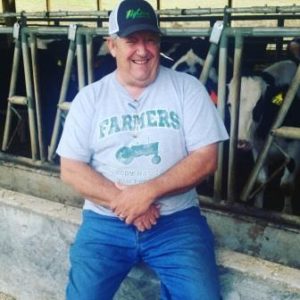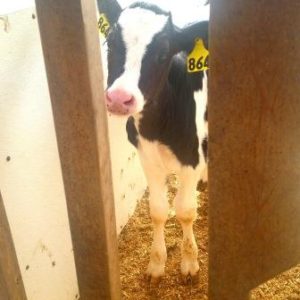Strolling through Cane Creek Dairy Farm makes you feel as if you have turned back time to forty years ago, when the dairy farm first opened in Fletcher, NC. As you look around, you see many acres of farmland, wooden barns, rows of corn, and three hundred cows, mostly Holsteins, of all shapes and sizes. All of the barns separate the cows by age – there is a barn for calves, a barn for young heifers, a barn for the pregnant heifers, and a barn for dairy cows.

Excellent nutrition, hard work, and humane animal treatment allow a calf on Cane Creek Dairy Farm to grow and prosper as a dairy cow. Without the dedication of the Nesbitt Family and other dairy farms, consumers would not be able to benefit from the nutritional benefits provided in cow’s milk. Have you ever wondered how your cold glass of milk got onto your table? Let’s see how the Nesbitt family does it.

On the day I visited the farm, there was a newborn female calf only six hours old. My heart melted right then and there. The calf is separated from its mother within twenty-four hours, but the newborn will receive the colostrum from the mother’s milk. Think of colostrum as a powerful vaccination for a calf or child. Yes, both humans and cows provide colostrum to their young because they are both mammals! After receiving the nutritious colostrum, the calf will be given pasteurized milk and grain-based feed. Pasteurized milk is provided to reduce the risk of disease transmission to calves. Once the calf becomes a teenager (or yearling), her diet will switch to silage made from corn, hay, and grain-based feed. Silage is basically corn kimchi. The corn is harvested when it is green, piled up, and covered to allow it to ensile (or ferment)
A cow that is old enough to breed is known as a heifer. Heifers may become pregnant through natural breeding or artificial insemination (AI). Once the heifer gives birth to her own calf, she will be able to produce milk and enter the rotation at the milk parlor(the milking room), the heart of the farm. Guiding a 1,300-1,400 lb cow through a small parlor might seem challenging, but the flow of cow traffic was pleasant because they are handled with care and respect by the workers. The cows are milked three times a day by machine in four to five minute sessions. The farm used to milk the cows twice a day but switched to three times a day because it increased the cow’s milk production by 8%. A cow’s udders are cared for before and after milking to protect from infection and irritation. As they are being milked the milk will flow into a large tank along with the milk from other cows.
A cow’s milk is only as nutritious as the cow’s diet. How does Mr. Nesbitt know if a cow’s diet is healthy? He isn’t able to check her cholesterol or blood sugar levels. He checks the cow’s manure. It is a great way to monitor how much she is consuming on a daily basis because it is crucial for a cow to receive the correct amount of carbohydrates, fiber, protein, fat, vitamins, and minerals. The cows receive hay, grain-based feed, silage, and graze for four to five hours each day. In the warmer weather when grasses cover the hillsides, the cows graze out of doors for most of the day and their feed may be supplemented to make sure they get the right proportion of nutrients. Cane Creek Farm ensures one acre of land for every cow. Surprisingly, one of the cows’ favorite snacks might be one of your favorite snacks… cucumbers! They also enjoy apple pulp, citrus pulp, and other fruits and vegetables.
If the cow becomes sick, a veterinarian will decide if the animal needs antibiotics. The cow will be marked with red duct tape around her leg and the cow’s number will be documented to ensure the milk is always discarded. Before the milk leaves Cane Creek Dairy, it is tested on-site for antibiotics using a SNAP test. Once the milk has passed the SNAP test, a tankard comes by daily to pick up the load of raw milk and take it to MILKCO, the local milk processing and packaging facility in Asheville, NC. The raw milk will also be tested for antibiotics at MILKCO. You can rest assured that all milk in the dairy section is antibiotic-free. Vitamin D will be added to milk because it does not occur naturally and vitamin A will be added to all low-fat milk because vitamin A levels decrease when fat is removed from milk. Lastly, the milk is packaged into different sizes of jugs and bottles and shipped to the grocery store.
So the next time you grab a heavy gallon of milk from the dairy section, you will know it all started with a tiny baby calf.
